Manipulating Dark and Thana Tourism
VerifiedAdded on 2022/08/18
|10
|2844
|10
AI Summary
Korstanje (2012) and Lelo and Azim (2016), exploring the reasons of why as well as what the visitors happen to seek at the place of death has been portrayed as a key concern in studying the dark tourism in various contexts. According to Korstanje and George (2015), dark tourism depicts the sites where suffering or death has been able to determine the identity of specific community and it is where a public commemoration or private commoditization takes place.
Contribute Materials
Your contribution can guide someone’s learning journey. Share your
documents today.
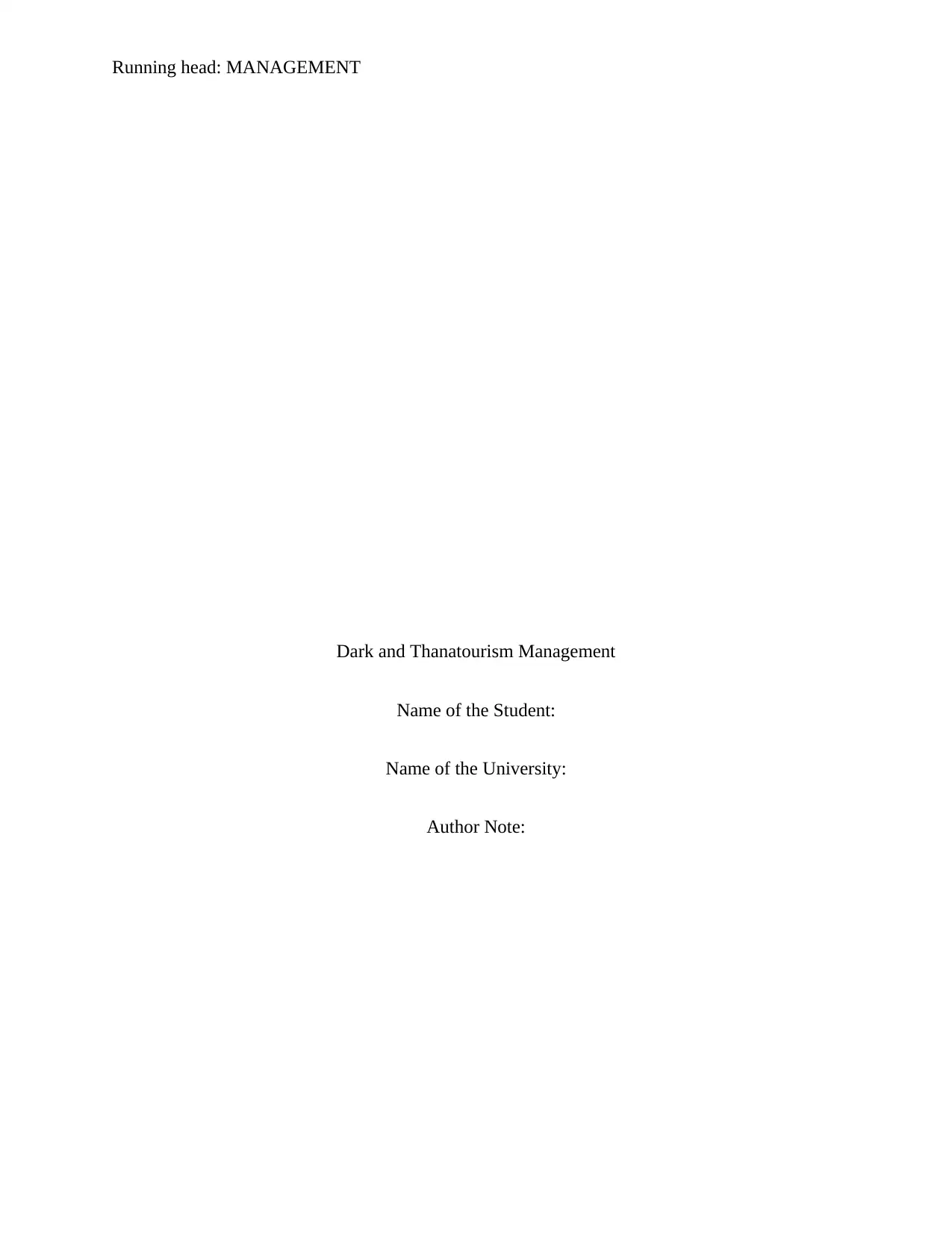
Running head: MANAGEMENT
Dark and Thanatourism Management
Name of the Student:
Name of the University:
Author Note:
Dark and Thanatourism Management
Name of the Student:
Name of the University:
Author Note:
Secure Best Marks with AI Grader
Need help grading? Try our AI Grader for instant feedback on your assignments.
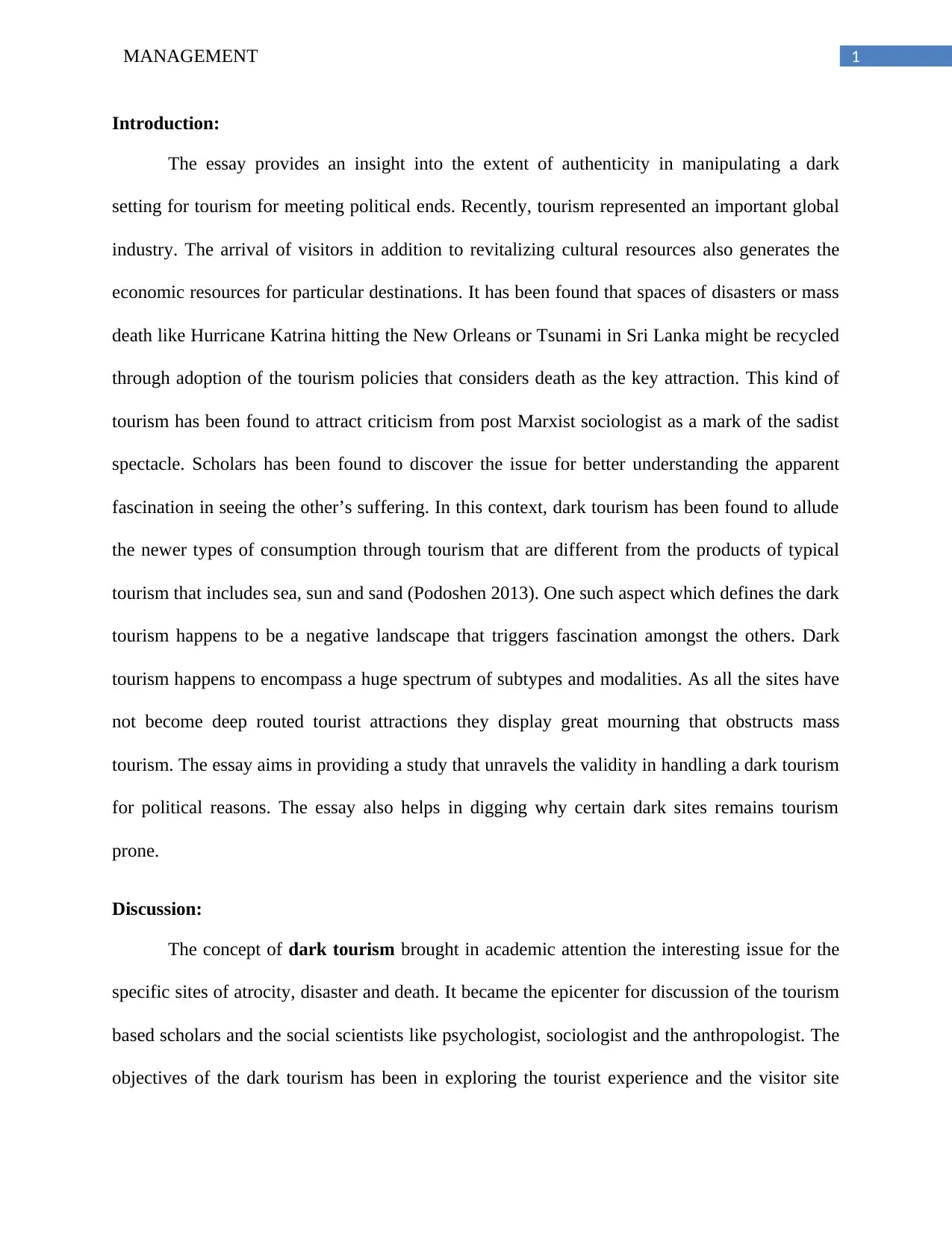
MANAGEMENT 1
Introduction:
The essay provides an insight into the extent of authenticity in manipulating a dark
setting for tourism for meeting political ends. Recently, tourism represented an important global
industry. The arrival of visitors in addition to revitalizing cultural resources also generates the
economic resources for particular destinations. It has been found that spaces of disasters or mass
death like Hurricane Katrina hitting the New Orleans or Tsunami in Sri Lanka might be recycled
through adoption of the tourism policies that considers death as the key attraction. This kind of
tourism has been found to attract criticism from post Marxist sociologist as a mark of the sadist
spectacle. Scholars has been found to discover the issue for better understanding the apparent
fascination in seeing the other’s suffering. In this context, dark tourism has been found to allude
the newer types of consumption through tourism that are different from the products of typical
tourism that includes sea, sun and sand (Podoshen 2013). One such aspect which defines the dark
tourism happens to be a negative landscape that triggers fascination amongst the others. Dark
tourism happens to encompass a huge spectrum of subtypes and modalities. As all the sites have
not become deep routed tourist attractions they display great mourning that obstructs mass
tourism. The essay aims in providing a study that unravels the validity in handling a dark tourism
for political reasons. The essay also helps in digging why certain dark sites remains tourism
prone.
Discussion:
The concept of dark tourism brought in academic attention the interesting issue for the
specific sites of atrocity, disaster and death. It became the epicenter for discussion of the tourism
based scholars and the social scientists like psychologist, sociologist and the anthropologist. The
objectives of the dark tourism has been in exploring the tourist experience and the visitor site
Introduction:
The essay provides an insight into the extent of authenticity in manipulating a dark
setting for tourism for meeting political ends. Recently, tourism represented an important global
industry. The arrival of visitors in addition to revitalizing cultural resources also generates the
economic resources for particular destinations. It has been found that spaces of disasters or mass
death like Hurricane Katrina hitting the New Orleans or Tsunami in Sri Lanka might be recycled
through adoption of the tourism policies that considers death as the key attraction. This kind of
tourism has been found to attract criticism from post Marxist sociologist as a mark of the sadist
spectacle. Scholars has been found to discover the issue for better understanding the apparent
fascination in seeing the other’s suffering. In this context, dark tourism has been found to allude
the newer types of consumption through tourism that are different from the products of typical
tourism that includes sea, sun and sand (Podoshen 2013). One such aspect which defines the dark
tourism happens to be a negative landscape that triggers fascination amongst the others. Dark
tourism happens to encompass a huge spectrum of subtypes and modalities. As all the sites have
not become deep routed tourist attractions they display great mourning that obstructs mass
tourism. The essay aims in providing a study that unravels the validity in handling a dark tourism
for political reasons. The essay also helps in digging why certain dark sites remains tourism
prone.
Discussion:
The concept of dark tourism brought in academic attention the interesting issue for the
specific sites of atrocity, disaster and death. It became the epicenter for discussion of the tourism
based scholars and the social scientists like psychologist, sociologist and the anthropologist. The
objectives of the dark tourism has been in exploring the tourist experience and the visitor site
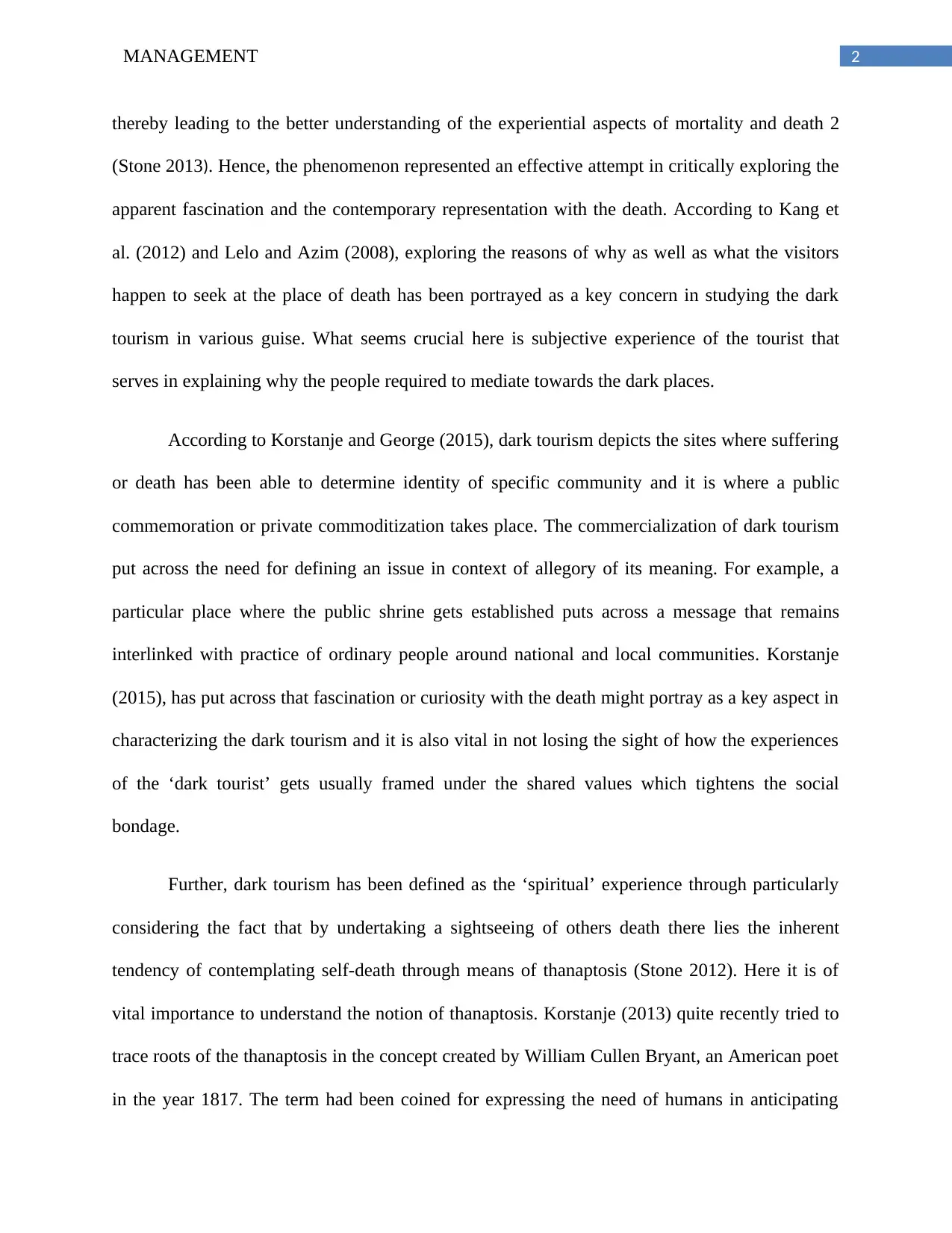
2MANAGEMENT
thereby leading to the better understanding of the experiential aspects of mortality and death 2
(Stone 2013). Hence, the phenomenon represented an effective attempt in critically exploring the
apparent fascination and the contemporary representation with the death. According to Kang et
al. (2012) and Lelo and Azim (2008), exploring the reasons of why as well as what the visitors
happen to seek at the place of death has been portrayed as a key concern in studying the dark
tourism in various guise. What seems crucial here is subjective experience of the tourist that
serves in explaining why the people required to mediate towards the dark places.
According to Korstanje and George (2015), dark tourism depicts the sites where suffering
or death has been able to determine identity of specific community and it is where a public
commemoration or private commoditization takes place. The commercialization of dark tourism
put across the need for defining an issue in context of allegory of its meaning. For example, a
particular place where the public shrine gets established puts across a message that remains
interlinked with practice of ordinary people around national and local communities. Korstanje
(2015), has put across that fascination or curiosity with the death might portray as a key aspect in
characterizing the dark tourism and it is also vital in not losing the sight of how the experiences
of the ‘dark tourist’ gets usually framed under the shared values which tightens the social
bondage.
Further, dark tourism has been defined as the ‘spiritual’ experience through particularly
considering the fact that by undertaking a sightseeing of others death there lies the inherent
tendency of contemplating self-death through means of thanaptosis (Stone 2012). Here it is of
vital importance to understand the notion of thanaptosis. Korstanje (2013) quite recently tried to
trace roots of the thanaptosis in the concept created by William Cullen Bryant, an American poet
in the year 1817. The term had been coined for expressing the need of humans in anticipating
thereby leading to the better understanding of the experiential aspects of mortality and death 2
(Stone 2013). Hence, the phenomenon represented an effective attempt in critically exploring the
apparent fascination and the contemporary representation with the death. According to Kang et
al. (2012) and Lelo and Azim (2008), exploring the reasons of why as well as what the visitors
happen to seek at the place of death has been portrayed as a key concern in studying the dark
tourism in various guise. What seems crucial here is subjective experience of the tourist that
serves in explaining why the people required to mediate towards the dark places.
According to Korstanje and George (2015), dark tourism depicts the sites where suffering
or death has been able to determine identity of specific community and it is where a public
commemoration or private commoditization takes place. The commercialization of dark tourism
put across the need for defining an issue in context of allegory of its meaning. For example, a
particular place where the public shrine gets established puts across a message that remains
interlinked with practice of ordinary people around national and local communities. Korstanje
(2015), has put across that fascination or curiosity with the death might portray as a key aspect in
characterizing the dark tourism and it is also vital in not losing the sight of how the experiences
of the ‘dark tourist’ gets usually framed under the shared values which tightens the social
bondage.
Further, dark tourism has been defined as the ‘spiritual’ experience through particularly
considering the fact that by undertaking a sightseeing of others death there lies the inherent
tendency of contemplating self-death through means of thanaptosis (Stone 2012). Here it is of
vital importance to understand the notion of thanaptosis. Korstanje (2013) quite recently tried to
trace roots of the thanaptosis in the concept created by William Cullen Bryant, an American poet
in the year 1817. The term had been coined for expressing the need of humans in anticipating
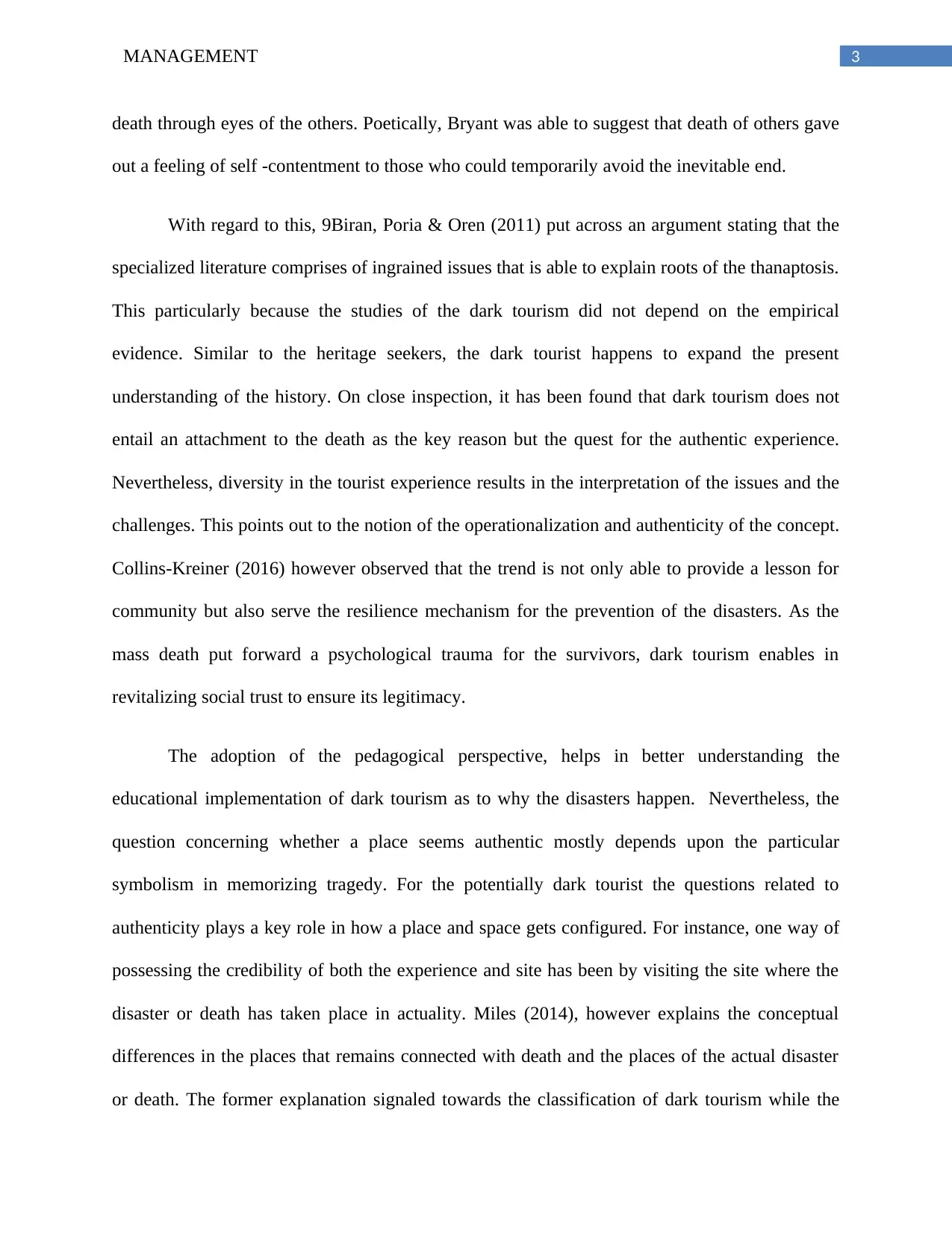
3MANAGEMENT
death through eyes of the others. Poetically, Bryant was able to suggest that death of others gave
out a feeling of self -contentment to those who could temporarily avoid the inevitable end.
With regard to this, 9Biran, Poria & Oren (2011) put across an argument stating that the
specialized literature comprises of ingrained issues that is able to explain roots of the thanaptosis.
This particularly because the studies of the dark tourism did not depend on the empirical
evidence. Similar to the heritage seekers, the dark tourist happens to expand the present
understanding of the history. On close inspection, it has been found that dark tourism does not
entail an attachment to the death as the key reason but the quest for the authentic experience.
Nevertheless, diversity in the tourist experience results in the interpretation of the issues and the
challenges. This points out to the notion of the operationalization and authenticity of the concept.
Collins-Kreiner (2016) however observed that the trend is not only able to provide a lesson for
community but also serve the resilience mechanism for the prevention of the disasters. As the
mass death put forward a psychological trauma for the survivors, dark tourism enables in
revitalizing social trust to ensure its legitimacy.
The adoption of the pedagogical perspective, helps in better understanding the
educational implementation of dark tourism as to why the disasters happen. Nevertheless, the
question concerning whether a place seems authentic mostly depends upon the particular
symbolism in memorizing tragedy. For the potentially dark tourist the questions related to
authenticity plays a key role in how a place and space gets configured. For instance, one way of
possessing the credibility of both the experience and site has been by visiting the site where the
disaster or death has taken place in actuality. Miles (2014), however explains the conceptual
differences in the places that remains connected with death and the places of the actual disaster
or death. The former explanation signaled towards the classification of dark tourism while the
death through eyes of the others. Poetically, Bryant was able to suggest that death of others gave
out a feeling of self -contentment to those who could temporarily avoid the inevitable end.
With regard to this, 9Biran, Poria & Oren (2011) put across an argument stating that the
specialized literature comprises of ingrained issues that is able to explain roots of the thanaptosis.
This particularly because the studies of the dark tourism did not depend on the empirical
evidence. Similar to the heritage seekers, the dark tourist happens to expand the present
understanding of the history. On close inspection, it has been found that dark tourism does not
entail an attachment to the death as the key reason but the quest for the authentic experience.
Nevertheless, diversity in the tourist experience results in the interpretation of the issues and the
challenges. This points out to the notion of the operationalization and authenticity of the concept.
Collins-Kreiner (2016) however observed that the trend is not only able to provide a lesson for
community but also serve the resilience mechanism for the prevention of the disasters. As the
mass death put forward a psychological trauma for the survivors, dark tourism enables in
revitalizing social trust to ensure its legitimacy.
The adoption of the pedagogical perspective, helps in better understanding the
educational implementation of dark tourism as to why the disasters happen. Nevertheless, the
question concerning whether a place seems authentic mostly depends upon the particular
symbolism in memorizing tragedy. For the potentially dark tourist the questions related to
authenticity plays a key role in how a place and space gets configured. For instance, one way of
possessing the credibility of both the experience and site has been by visiting the site where the
disaster or death has taken place in actuality. Miles (2014), however explains the conceptual
differences in the places that remains connected with death and the places of the actual disaster
or death. The former explanation signaled towards the classification of dark tourism while the
Secure Best Marks with AI Grader
Need help grading? Try our AI Grader for instant feedback on your assignments.
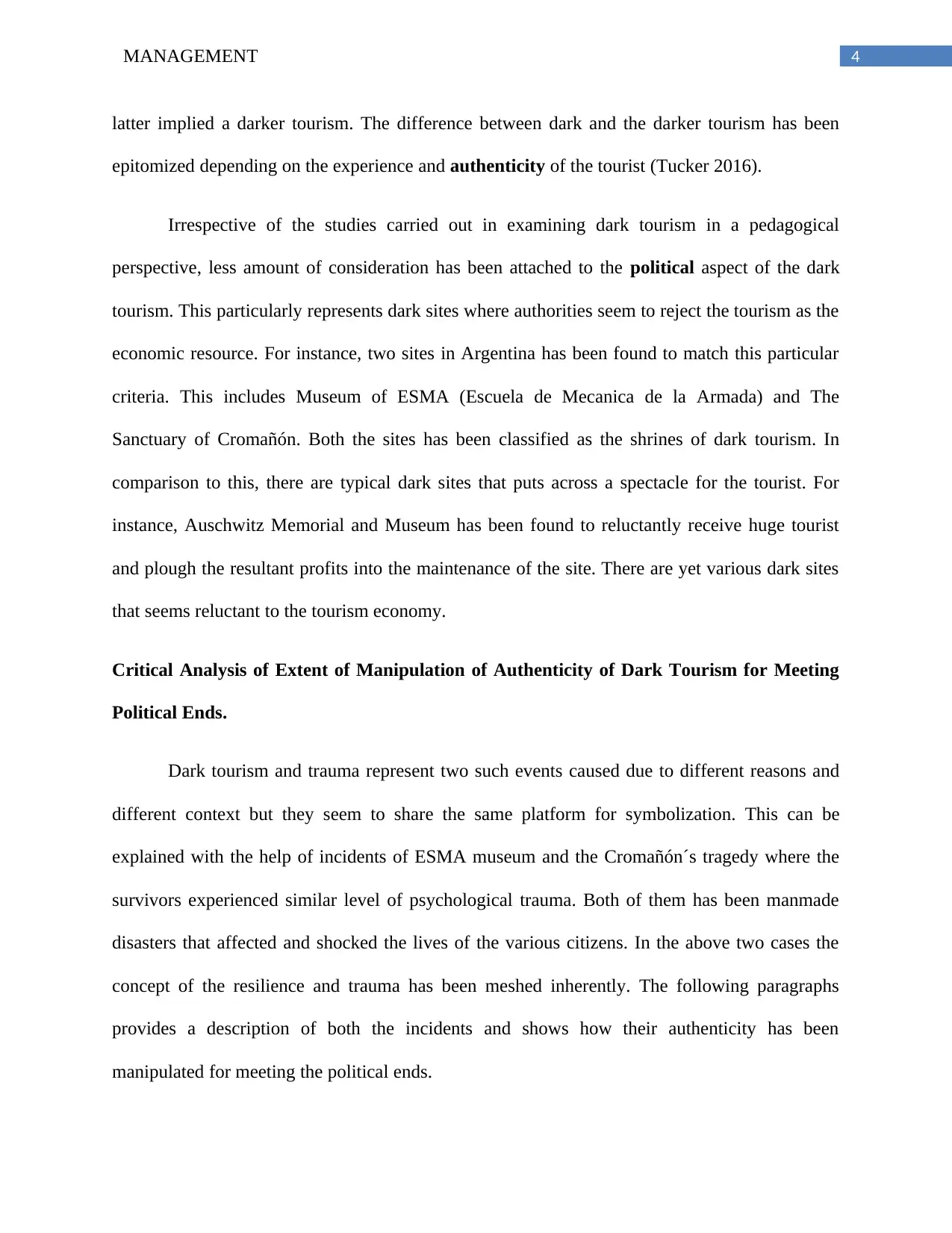
4MANAGEMENT
latter implied a darker tourism. The difference between dark and the darker tourism has been
epitomized depending on the experience and authenticity of the tourist (Tucker 2016).
Irrespective of the studies carried out in examining dark tourism in a pedagogical
perspective, less amount of consideration has been attached to the political aspect of the dark
tourism. This particularly represents dark sites where authorities seem to reject the tourism as the
economic resource. For instance, two sites in Argentina has been found to match this particular
criteria. This includes Museum of ESMA (Escuela de Mecanica de la Armada) and The
Sanctuary of Cromañón. Both the sites has been classified as the shrines of dark tourism. In
comparison to this, there are typical dark sites that puts across a spectacle for the tourist. For
instance, Auschwitz Memorial and Museum has been found to reluctantly receive huge tourist
and plough the resultant profits into the maintenance of the site. There are yet various dark sites
that seems reluctant to the tourism economy.
Critical Analysis of Extent of Manipulation of Authenticity of Dark Tourism for Meeting
Political Ends.
Dark tourism and trauma represent two such events caused due to different reasons and
different context but they seem to share the same platform for symbolization. This can be
explained with the help of incidents of ESMA museum and the Cromañón´s tragedy where the
survivors experienced similar level of psychological trauma. Both of them has been manmade
disasters that affected and shocked the lives of the various citizens. In the above two cases the
concept of the resilience and trauma has been meshed inherently. The following paragraphs
provides a description of both the incidents and shows how their authenticity has been
manipulated for meeting the political ends.
latter implied a darker tourism. The difference between dark and the darker tourism has been
epitomized depending on the experience and authenticity of the tourist (Tucker 2016).
Irrespective of the studies carried out in examining dark tourism in a pedagogical
perspective, less amount of consideration has been attached to the political aspect of the dark
tourism. This particularly represents dark sites where authorities seem to reject the tourism as the
economic resource. For instance, two sites in Argentina has been found to match this particular
criteria. This includes Museum of ESMA (Escuela de Mecanica de la Armada) and The
Sanctuary of Cromañón. Both the sites has been classified as the shrines of dark tourism. In
comparison to this, there are typical dark sites that puts across a spectacle for the tourist. For
instance, Auschwitz Memorial and Museum has been found to reluctantly receive huge tourist
and plough the resultant profits into the maintenance of the site. There are yet various dark sites
that seems reluctant to the tourism economy.
Critical Analysis of Extent of Manipulation of Authenticity of Dark Tourism for Meeting
Political Ends.
Dark tourism and trauma represent two such events caused due to different reasons and
different context but they seem to share the same platform for symbolization. This can be
explained with the help of incidents of ESMA museum and the Cromañón´s tragedy where the
survivors experienced similar level of psychological trauma. Both of them has been manmade
disasters that affected and shocked the lives of the various citizens. In the above two cases the
concept of the resilience and trauma has been meshed inherently. The following paragraphs
provides a description of both the incidents and shows how their authenticity has been
manipulated for meeting the political ends.
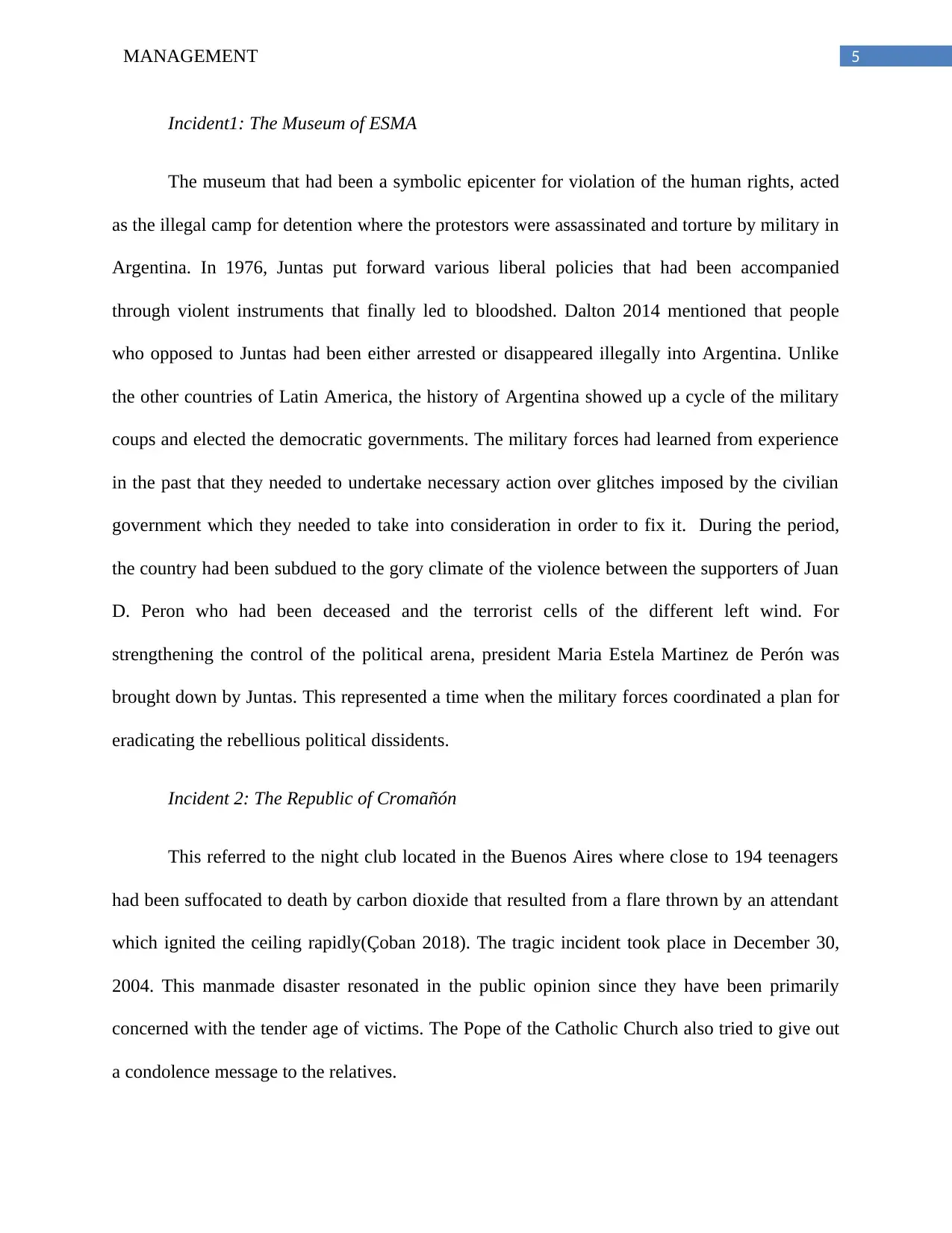
5MANAGEMENT
Incident1: The Museum of ESMA
The museum that had been a symbolic epicenter for violation of the human rights, acted
as the illegal camp for detention where the protestors were assassinated and torture by military in
Argentina. In 1976, Juntas put forward various liberal policies that had been accompanied
through violent instruments that finally led to bloodshed. Dalton 2014 mentioned that people
who opposed to Juntas had been either arrested or disappeared illegally into Argentina. Unlike
the other countries of Latin America, the history of Argentina showed up a cycle of the military
coups and elected the democratic governments. The military forces had learned from experience
in the past that they needed to undertake necessary action over glitches imposed by the civilian
government which they needed to take into consideration in order to fix it. During the period,
the country had been subdued to the gory climate of the violence between the supporters of Juan
D. Peron who had been deceased and the terrorist cells of the different left wind. For
strengthening the control of the political arena, president Maria Estela Martinez de Perón was
brought down by Juntas. This represented a time when the military forces coordinated a plan for
eradicating the rebellious political dissidents.
Incident 2: The Republic of Cromañón
This referred to the night club located in the Buenos Aires where close to 194 teenagers
had been suffocated to death by carbon dioxide that resulted from a flare thrown by an attendant
which ignited the ceiling rapidly(Çoban 2018). The tragic incident took place in December 30,
2004. This manmade disaster resonated in the public opinion since they have been primarily
concerned with the tender age of victims. The Pope of the Catholic Church also tried to give out
a condolence message to the relatives.
Incident1: The Museum of ESMA
The museum that had been a symbolic epicenter for violation of the human rights, acted
as the illegal camp for detention where the protestors were assassinated and torture by military in
Argentina. In 1976, Juntas put forward various liberal policies that had been accompanied
through violent instruments that finally led to bloodshed. Dalton 2014 mentioned that people
who opposed to Juntas had been either arrested or disappeared illegally into Argentina. Unlike
the other countries of Latin America, the history of Argentina showed up a cycle of the military
coups and elected the democratic governments. The military forces had learned from experience
in the past that they needed to undertake necessary action over glitches imposed by the civilian
government which they needed to take into consideration in order to fix it. During the period,
the country had been subdued to the gory climate of the violence between the supporters of Juan
D. Peron who had been deceased and the terrorist cells of the different left wind. For
strengthening the control of the political arena, president Maria Estela Martinez de Perón was
brought down by Juntas. This represented a time when the military forces coordinated a plan for
eradicating the rebellious political dissidents.
Incident 2: The Republic of Cromañón
This referred to the night club located in the Buenos Aires where close to 194 teenagers
had been suffocated to death by carbon dioxide that resulted from a flare thrown by an attendant
which ignited the ceiling rapidly(Çoban 2018). The tragic incident took place in December 30,
2004. This manmade disaster resonated in the public opinion since they have been primarily
concerned with the tender age of victims. The Pope of the Catholic Church also tried to give out
a condolence message to the relatives.
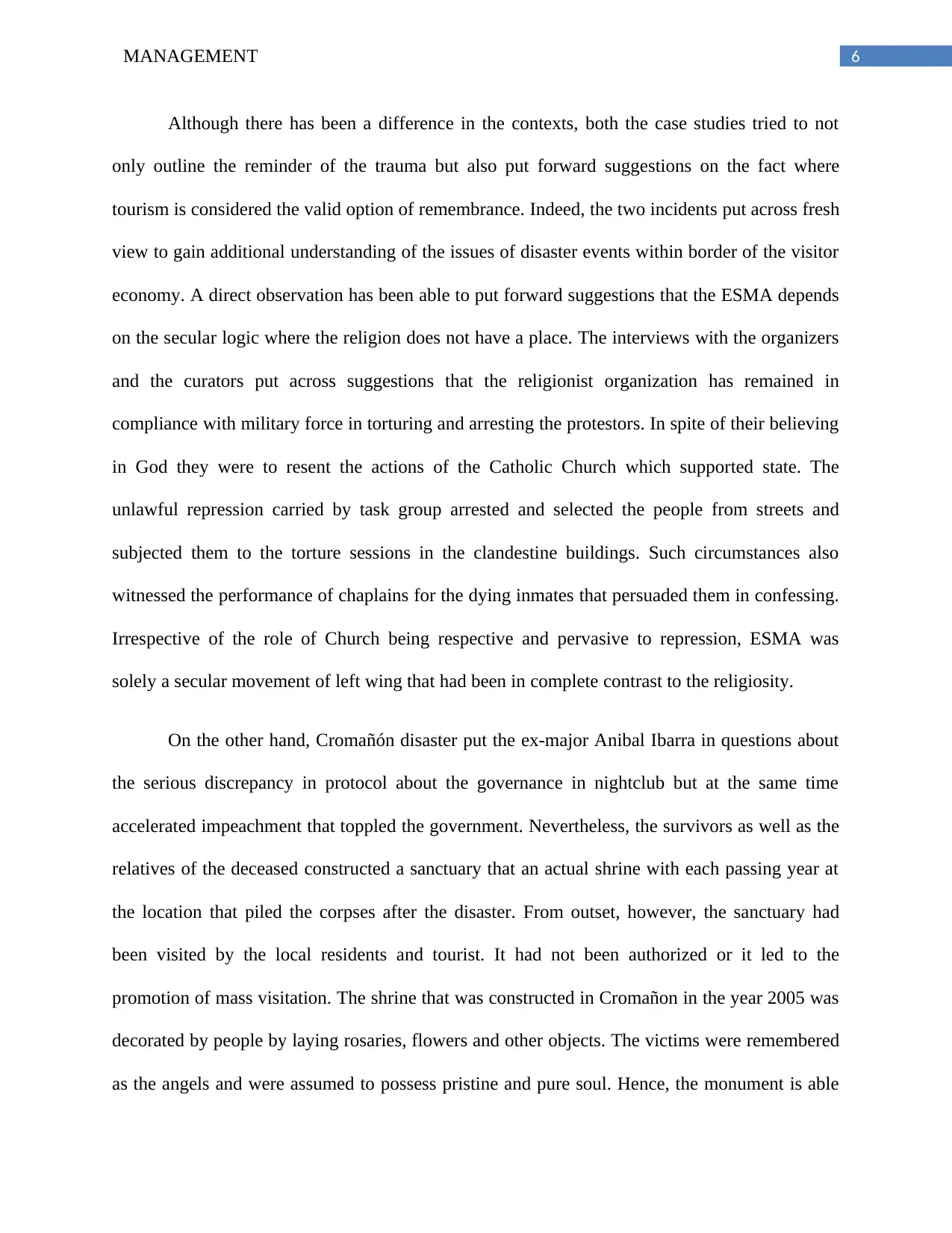
6MANAGEMENT
Although there has been a difference in the contexts, both the case studies tried to not
only outline the reminder of the trauma but also put forward suggestions on the fact where
tourism is considered the valid option of remembrance. Indeed, the two incidents put across fresh
view to gain additional understanding of the issues of disaster events within border of the visitor
economy. A direct observation has been able to put forward suggestions that the ESMA depends
on the secular logic where the religion does not have a place. The interviews with the organizers
and the curators put across suggestions that the religionist organization has remained in
compliance with military force in torturing and arresting the protestors. In spite of their believing
in God they were to resent the actions of the Catholic Church which supported state. The
unlawful repression carried by task group arrested and selected the people from streets and
subjected them to the torture sessions in the clandestine buildings. Such circumstances also
witnessed the performance of chaplains for the dying inmates that persuaded them in confessing.
Irrespective of the role of Church being respective and pervasive to repression, ESMA was
solely a secular movement of left wing that had been in complete contrast to the religiosity.
On the other hand, Cromañón disaster put the ex-major Anibal Ibarra in questions about
the serious discrepancy in protocol about the governance in nightclub but at the same time
accelerated impeachment that toppled the government. Nevertheless, the survivors as well as the
relatives of the deceased constructed a sanctuary that an actual shrine with each passing year at
the location that piled the corpses after the disaster. From outset, however, the sanctuary had
been visited by the local residents and tourist. It had not been authorized or it led to the
promotion of mass visitation. The shrine that was constructed in Cromañon in the year 2005 was
decorated by people by laying rosaries, flowers and other objects. The victims were remembered
as the angels and were assumed to possess pristine and pure soul. Hence, the monument is able
Although there has been a difference in the contexts, both the case studies tried to not
only outline the reminder of the trauma but also put forward suggestions on the fact where
tourism is considered the valid option of remembrance. Indeed, the two incidents put across fresh
view to gain additional understanding of the issues of disaster events within border of the visitor
economy. A direct observation has been able to put forward suggestions that the ESMA depends
on the secular logic where the religion does not have a place. The interviews with the organizers
and the curators put across suggestions that the religionist organization has remained in
compliance with military force in torturing and arresting the protestors. In spite of their believing
in God they were to resent the actions of the Catholic Church which supported state. The
unlawful repression carried by task group arrested and selected the people from streets and
subjected them to the torture sessions in the clandestine buildings. Such circumstances also
witnessed the performance of chaplains for the dying inmates that persuaded them in confessing.
Irrespective of the role of Church being respective and pervasive to repression, ESMA was
solely a secular movement of left wing that had been in complete contrast to the religiosity.
On the other hand, Cromañón disaster put the ex-major Anibal Ibarra in questions about
the serious discrepancy in protocol about the governance in nightclub but at the same time
accelerated impeachment that toppled the government. Nevertheless, the survivors as well as the
relatives of the deceased constructed a sanctuary that an actual shrine with each passing year at
the location that piled the corpses after the disaster. From outset, however, the sanctuary had
been visited by the local residents and tourist. It had not been authorized or it led to the
promotion of mass visitation. The shrine that was constructed in Cromañon in the year 2005 was
decorated by people by laying rosaries, flowers and other objects. The victims were remembered
as the angels and were assumed to possess pristine and pure soul. Hence, the monument is able
Paraphrase This Document
Need a fresh take? Get an instant paraphrase of this document with our AI Paraphraser
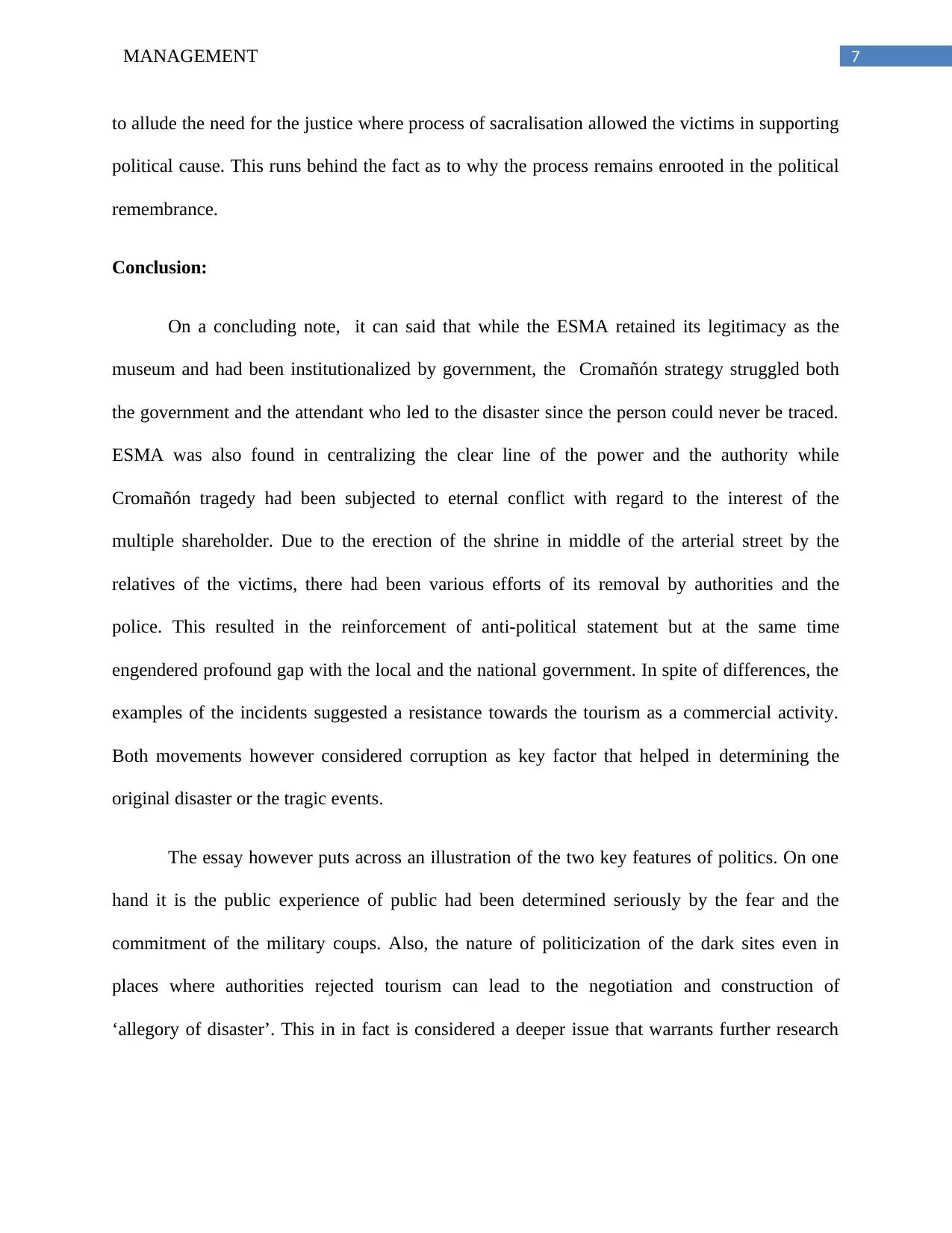
7MANAGEMENT
to allude the need for the justice where process of sacralisation allowed the victims in supporting
political cause. This runs behind the fact as to why the process remains enrooted in the political
remembrance.
Conclusion:
On a concluding note, it can said that while the ESMA retained its legitimacy as the
museum and had been institutionalized by government, the Cromañón strategy struggled both
the government and the attendant who led to the disaster since the person could never be traced.
ESMA was also found in centralizing the clear line of the power and the authority while
Cromañón tragedy had been subjected to eternal conflict with regard to the interest of the
multiple shareholder. Due to the erection of the shrine in middle of the arterial street by the
relatives of the victims, there had been various efforts of its removal by authorities and the
police. This resulted in the reinforcement of anti-political statement but at the same time
engendered profound gap with the local and the national government. In spite of differences, the
examples of the incidents suggested a resistance towards the tourism as a commercial activity.
Both movements however considered corruption as key factor that helped in determining the
original disaster or the tragic events.
The essay however puts across an illustration of the two key features of politics. On one
hand it is the public experience of public had been determined seriously by the fear and the
commitment of the military coups. Also, the nature of politicization of the dark sites even in
places where authorities rejected tourism can lead to the negotiation and construction of
‘allegory of disaster’. This in in fact is considered a deeper issue that warrants further research
to allude the need for the justice where process of sacralisation allowed the victims in supporting
political cause. This runs behind the fact as to why the process remains enrooted in the political
remembrance.
Conclusion:
On a concluding note, it can said that while the ESMA retained its legitimacy as the
museum and had been institutionalized by government, the Cromañón strategy struggled both
the government and the attendant who led to the disaster since the person could never be traced.
ESMA was also found in centralizing the clear line of the power and the authority while
Cromañón tragedy had been subjected to eternal conflict with regard to the interest of the
multiple shareholder. Due to the erection of the shrine in middle of the arterial street by the
relatives of the victims, there had been various efforts of its removal by authorities and the
police. This resulted in the reinforcement of anti-political statement but at the same time
engendered profound gap with the local and the national government. In spite of differences, the
examples of the incidents suggested a resistance towards the tourism as a commercial activity.
Both movements however considered corruption as key factor that helped in determining the
original disaster or the tragic events.
The essay however puts across an illustration of the two key features of politics. On one
hand it is the public experience of public had been determined seriously by the fear and the
commitment of the military coups. Also, the nature of politicization of the dark sites even in
places where authorities rejected tourism can lead to the negotiation and construction of
‘allegory of disaster’. This in in fact is considered a deeper issue that warrants further research
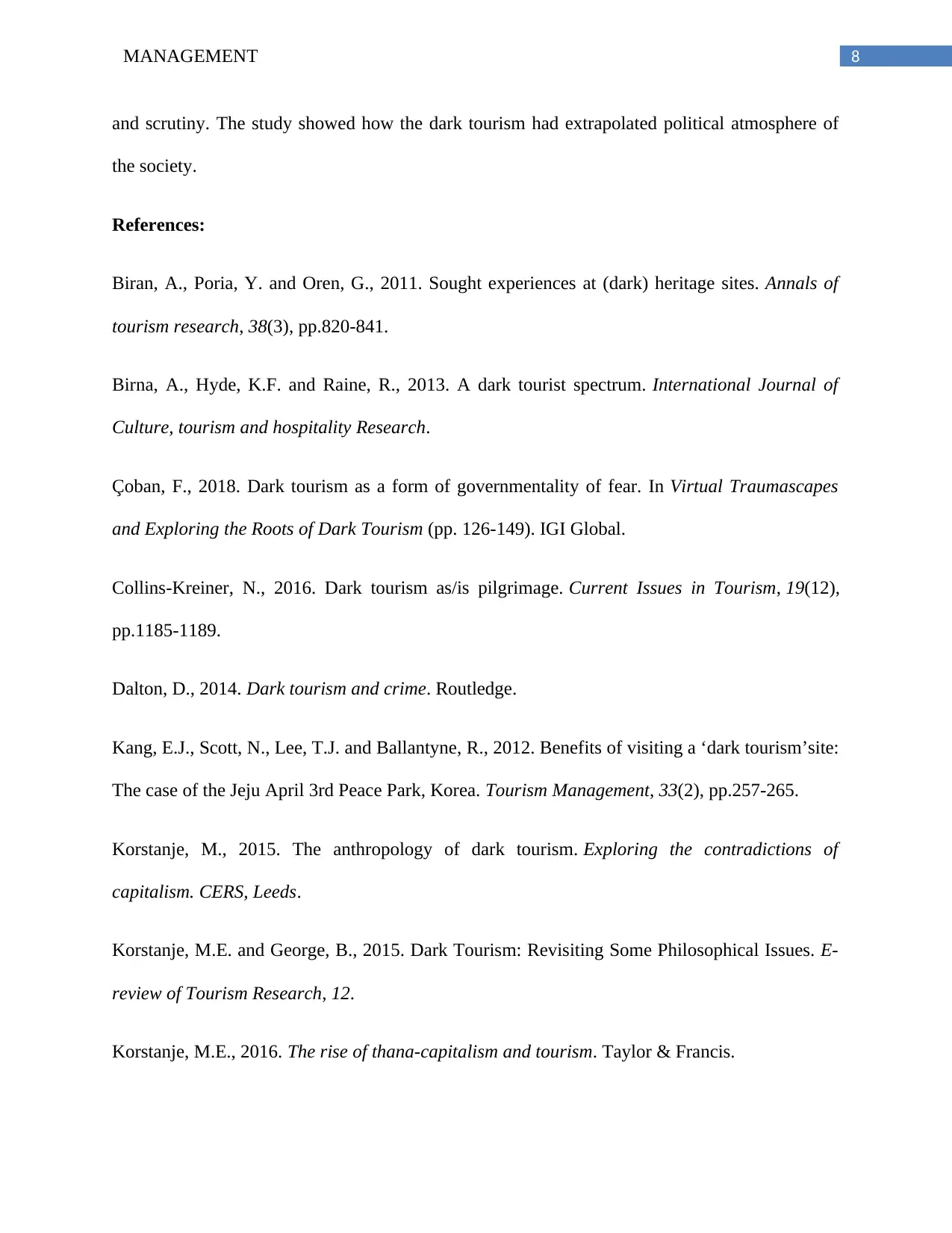
8MANAGEMENT
and scrutiny. The study showed how the dark tourism had extrapolated political atmosphere of
the society.
References:
Biran, A., Poria, Y. and Oren, G., 2011. Sought experiences at (dark) heritage sites. Annals of
tourism research, 38(3), pp.820-841.
Birna, A., Hyde, K.F. and Raine, R., 2013. A dark tourist spectrum. International Journal of
Culture, tourism and hospitality Research.
Çoban, F., 2018. Dark tourism as a form of governmentality of fear. In Virtual Traumascapes
and Exploring the Roots of Dark Tourism (pp. 126-149). IGI Global.
Collins-Kreiner, N., 2016. Dark tourism as/is pilgrimage. Current Issues in Tourism, 19(12),
pp.1185-1189.
Dalton, D., 2014. Dark tourism and crime. Routledge.
Kang, E.J., Scott, N., Lee, T.J. and Ballantyne, R., 2012. Benefits of visiting a ‘dark tourism’site:
The case of the Jeju April 3rd Peace Park, Korea. Tourism Management, 33(2), pp.257-265.
Korstanje, M., 2015. The anthropology of dark tourism. Exploring the contradictions of
capitalism. CERS, Leeds.
Korstanje, M.E. and George, B., 2015. Dark Tourism: Revisiting Some Philosophical Issues. E-
review of Tourism Research, 12.
Korstanje, M.E., 2016. The rise of thana-capitalism and tourism. Taylor & Francis.
and scrutiny. The study showed how the dark tourism had extrapolated political atmosphere of
the society.
References:
Biran, A., Poria, Y. and Oren, G., 2011. Sought experiences at (dark) heritage sites. Annals of
tourism research, 38(3), pp.820-841.
Birna, A., Hyde, K.F. and Raine, R., 2013. A dark tourist spectrum. International Journal of
Culture, tourism and hospitality Research.
Çoban, F., 2018. Dark tourism as a form of governmentality of fear. In Virtual Traumascapes
and Exploring the Roots of Dark Tourism (pp. 126-149). IGI Global.
Collins-Kreiner, N., 2016. Dark tourism as/is pilgrimage. Current Issues in Tourism, 19(12),
pp.1185-1189.
Dalton, D., 2014. Dark tourism and crime. Routledge.
Kang, E.J., Scott, N., Lee, T.J. and Ballantyne, R., 2012. Benefits of visiting a ‘dark tourism’site:
The case of the Jeju April 3rd Peace Park, Korea. Tourism Management, 33(2), pp.257-265.
Korstanje, M., 2015. The anthropology of dark tourism. Exploring the contradictions of
capitalism. CERS, Leeds.
Korstanje, M.E. and George, B., 2015. Dark Tourism: Revisiting Some Philosophical Issues. E-
review of Tourism Research, 12.
Korstanje, M.E., 2016. The rise of thana-capitalism and tourism. Taylor & Francis.
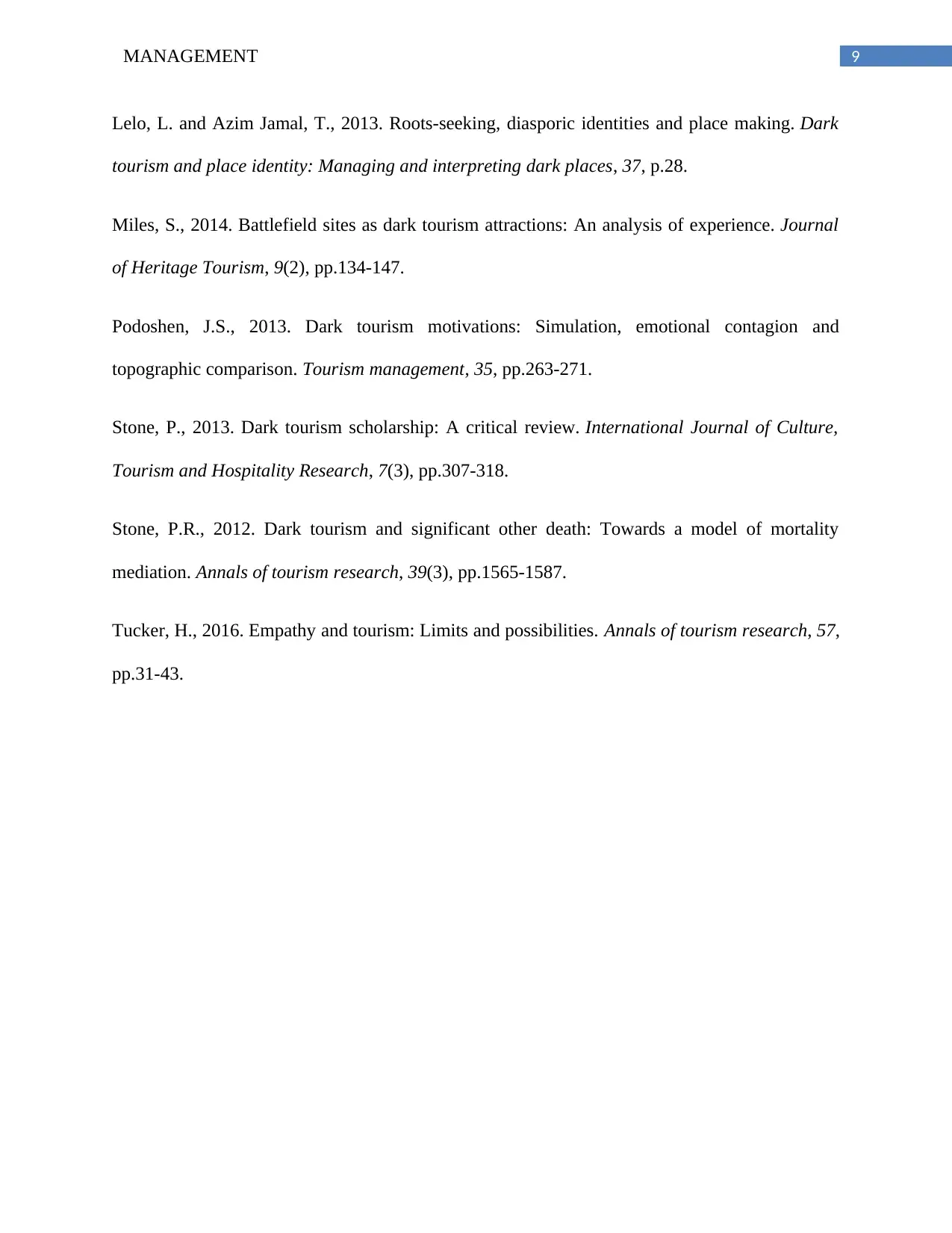
9MANAGEMENT
Lelo, L. and Azim Jamal, T., 2013. Roots-seeking, diasporic identities and place making. Dark
tourism and place identity: Managing and interpreting dark places, 37, p.28.
Miles, S., 2014. Battlefield sites as dark tourism attractions: An analysis of experience. Journal
of Heritage Tourism, 9(2), pp.134-147.
Podoshen, J.S., 2013. Dark tourism motivations: Simulation, emotional contagion and
topographic comparison. Tourism management, 35, pp.263-271.
Stone, P., 2013. Dark tourism scholarship: A critical review. International Journal of Culture,
Tourism and Hospitality Research, 7(3), pp.307-318.
Stone, P.R., 2012. Dark tourism and significant other death: Towards a model of mortality
mediation. Annals of tourism research, 39(3), pp.1565-1587.
Tucker, H., 2016. Empathy and tourism: Limits and possibilities. Annals of tourism research, 57,
pp.31-43.
Lelo, L. and Azim Jamal, T., 2013. Roots-seeking, diasporic identities and place making. Dark
tourism and place identity: Managing and interpreting dark places, 37, p.28.
Miles, S., 2014. Battlefield sites as dark tourism attractions: An analysis of experience. Journal
of Heritage Tourism, 9(2), pp.134-147.
Podoshen, J.S., 2013. Dark tourism motivations: Simulation, emotional contagion and
topographic comparison. Tourism management, 35, pp.263-271.
Stone, P., 2013. Dark tourism scholarship: A critical review. International Journal of Culture,
Tourism and Hospitality Research, 7(3), pp.307-318.
Stone, P.R., 2012. Dark tourism and significant other death: Towards a model of mortality
mediation. Annals of tourism research, 39(3), pp.1565-1587.
Tucker, H., 2016. Empathy and tourism: Limits and possibilities. Annals of tourism research, 57,
pp.31-43.
1 out of 10
Related Documents
Your All-in-One AI-Powered Toolkit for Academic Success.
+13062052269
info@desklib.com
Available 24*7 on WhatsApp / Email
![[object Object]](/_next/static/media/star-bottom.7253800d.svg)
Unlock your academic potential
© 2024 | Zucol Services PVT LTD | All rights reserved.





